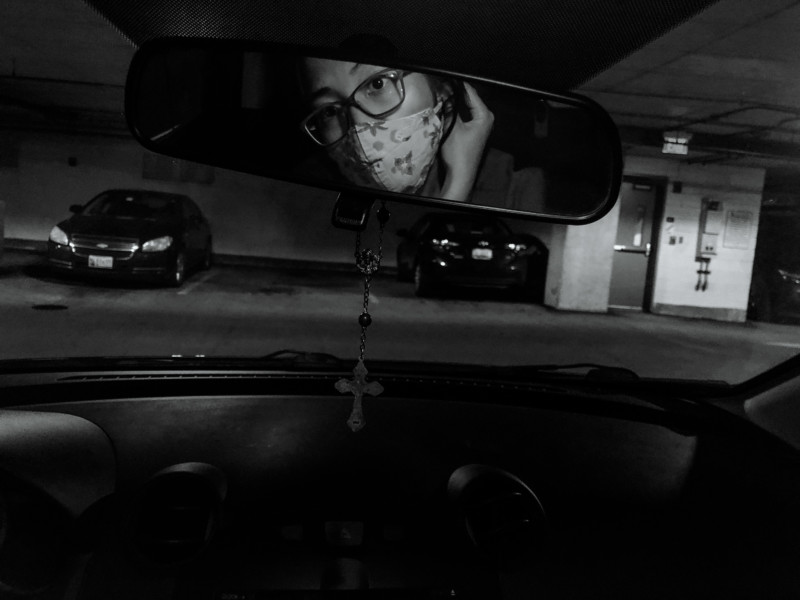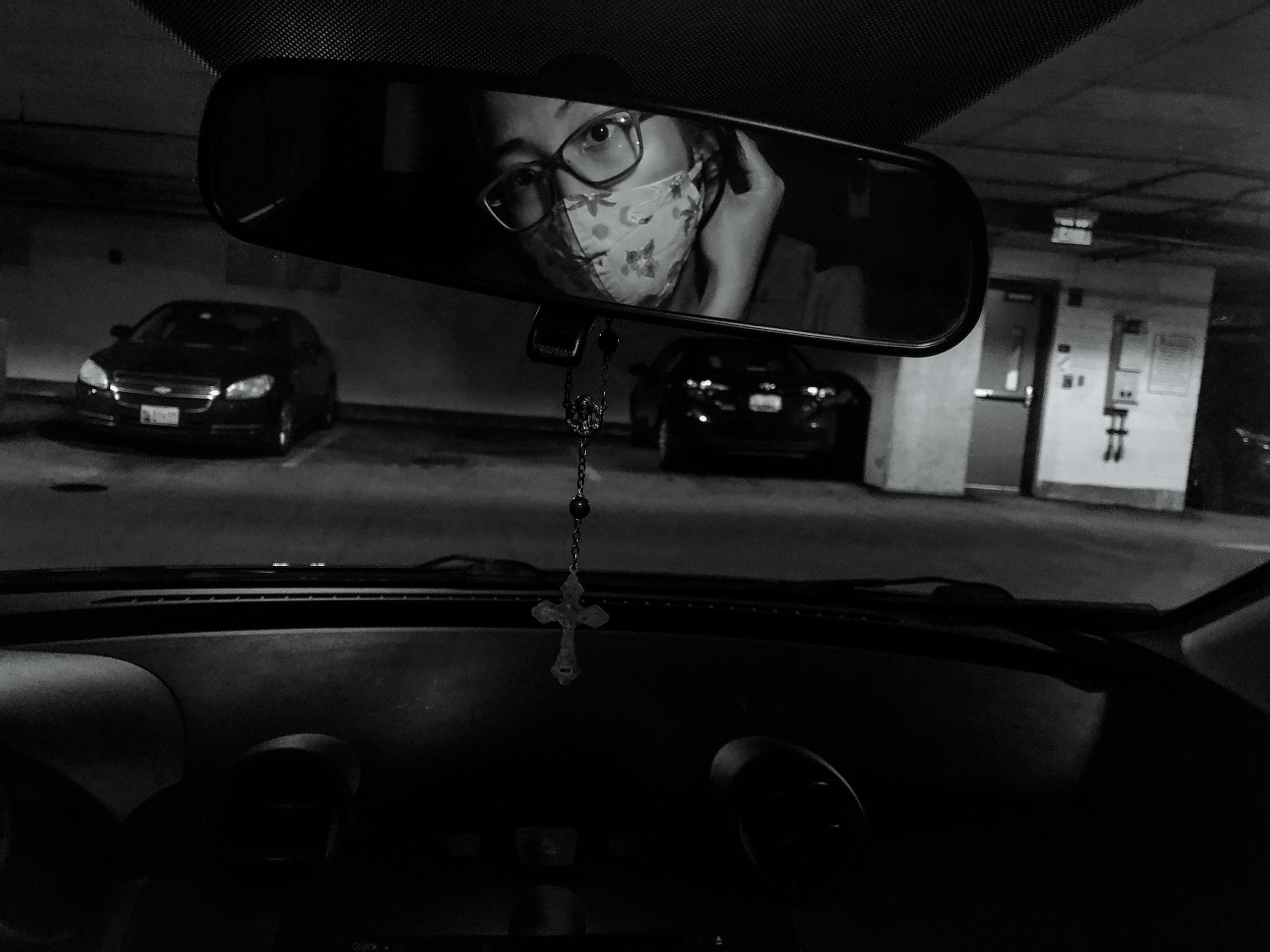Rosem Morton, a nurse for eight years, works full-time at a Baltimore hospital. When she isn’t assisting airway surgeries and distributing personal protective equipment to coworkers, she works as a freelance photojournalist and documentary photographer, focusing on healthcare, trauma, and resilience. Since the onset of the pandemic, much of her work concerns covid-19, the disease caused by the novel coronavirus.
Morton has a penchant for first-person storytelling. In 2019, CNN published Morton’s first-person photo-essay about her experiences as a rape survivor. “If there was not enough proof, it did not happen,” Morton wrote in that essay. “I kept photographing my proof. The proof of my struggle, of my survival. I learned to process through the lens of a camera.”
Since then, Morton, who is the recipient of a National Geographic Explorer grant, has been published in the New York Times, NPR, the Washington Post, Reuters, and ProPublica, among other news outlets. Her most recent contribution to National Geographic documents her work as a nurse during the pandemic, and the emotional toll it takes.
That work, as with many of Morton’s images, reveals the photographer’s life and perspective by locating tensions in quiet, everyday moments. She eschews shock value; still, the emotions in her photographs are palpable. Her self-portraits convey a sense of exhaustion as she looks at the camera; there are lines on her face from hours spent in an N95 mask. She does not directly portray her patients; rather, she offers symbols that conjure a world of treatment: a thermometer; shoes wrapped in plastic; her own hands, cracked from washing. The National Geographic series includes a screenshot of a conversation with her husband (“Hi love, just a heads up. It’s a covid day for me. I did not have eye protection outside my glasses”), as well as photos taken at her home, during moments of respite—a tea ceremony, or taking in the sun outside.
Eight days on the front: A nurse recounts fighting to get protective gear and arguing about changing work rules while operating to save stricken patients. "Something is brewing," she writes, "but I don’t have time to investigate." https://t.co/QXw41r7g3A #COVID2019 #coronavirus
— David Beard (@dabeard) April 3, 2020
Morton spoke with CJR about the intersections of healthcare and photojournalism, and what practitioners of each might learn from the other. Our conversation has been edited for length and clarity.
As a nurse, in a caring profession, you always care about what the other person is feeling and thinking.
What constraints did you face when producing the National Geographic photo-essay?
I was very careful about hipaa laws. And I think that really hindered the work a lot. At the same time, the workflow: I wanted to capture that as it was happening, like day-to-day, but you can’t really stop somebody and photograph their day when you’re also working [as a nurse]. I think, in a way, it just worked out that the story was [focused] on me and what I was seeing. It really ended up being a much quieter take on what hospital life looks like than other images that people have seen.
How have people responded?
People have reached out to check in, to see how I’m doing and to see how my fellow coworkers are doing, and I really am so grateful about that kind of response. I’ve also had people send in PPE, donations, gifts, things like that—which I think shows how much connection people develop in reading and in digesting these stories.
What challenges come with being both the photographer and the subject?
There are things that you can’t physically capture as a photographer and as the subject at the same time. I can’t photograph myself decontaminating when I get home because that will interfere with the whole process and cause it to break down.
But at the same time, you can experiment: you do know your story the best, and you’re able to explore other emotions creatively.
For example, I photographed how dry my hands are from the constant hand washing and use of hand sanitizer. I am drawn to this image because it also reminds me of stress lines in people’s faces. In this moment, my working hands carry the stress.
For my survivor work, I photographed my internal emotions—one of which, early on, was feeling broken. I saw these emotional representations in many instances—for example, when I took walks, and with my choice of meals.

Photo courtesy of Morton
How has first-person storytelling informed your craft?
As a young woman, I lived in the Philippines, where you have to always listen to the elders and to your male counterpart. And I just didn’t put a lot of value in what I had to say and what I had to contribute. Telling my story, in many ways, empowered me. I learned what it means to be a subject of a story, what it means to put your life in the open.
How does your work as a nurse shape your work as a photojournalist, and vice versa?
I think both roles offer you a lot of exercises in empathy. As a nurse, in a caring profession, you always care about what the other person is feeling and thinking.
Documenting the pandemic, the health workers are my community, and I know how they’re feeling and what it’s like. So it’s a different kind of empathy, because it’s a true understanding of what they’re going through. I’m also a person who understands what it feels like to put something traumatic out there. I understand the repercussions of their lives being publicized. And I feel like that offers me this insight and this understanding, this carefulness in documenting things.
What does your photography show that mainstream photojournalism during the pandemic might not?
I am able to show the intimacy behind the lives of people who work on the front lines. I take images of how I keep my masks in paper bags to prolong [their] usage. I am also able to take images of how I am affected by exposures: taking my temperature, taking other precautions, communicating openly with my partner. All of these are small details that may not make it in the mainstream coverage but are important aspects of life on the front lines.
I think the stories we’ve seen right now are like, What it’s like in the covid unit? A hospital is a really big place. There are more stories in there. Everybody is affected in a different way. And there are so many stories you can do aside from the covid unit. But, unfortunately, we just don’t have access to that. I don’t think anybody really does.
The nature of covid-19 is that it’s universal, and it could affect anyone, which I think opens up storytelling in different ways. You can still cover the stories you’re passionate about through the lens of covid-19. If you’re a person who cares about farming, how is covid-19 affecting farming? If you care about the LGBTQ community, how are they faring?
Do you think the images published so far are enough to show the damaging effects of covid?
There’s just too much misinformation out there. And I don’t think it’s necessarily going to be solved by more dramatic images of people suffering. I’m one of those people who always wonder whether there’s another way to get people to care without having an extremely horrifying or extremely graphic image. I don’t know the answer to that. I think we’ve just been so programmed that that’s what we need to care.
How important is lived experience in your work?
I think our lived experiences shape a lot of our storytelling. It provides a different kind of connection with your subjects—and possibly a deeper connection. I don’t want to limit people to just photographing experiences that relate to them. I’d like to think that we have a lot more empathy to go out of that box and still pursue other stories. But, given that we are going outside of our own boxes to pursue stories that we may not always have a full understanding of, I think it’s also important to be careful about how people are portrayed. One of the stereotypes for covid-19 that we saw early on were Asians wearing masks, which can enable anti-Asian racism.
Another stereotype is having just the healthcare staff be extremely exhausted, which is also true. But that is not our single truth. There are moments of happiness, and moments that we are also touched by our patients.
Pat Nabong is a visual journalist at the Chicago Sun-Times and an assistant editor at Reading the Pictures, a site dedicated to the analysis of news photography. Prior to joining the Sun-Times, she was supported by fellowships from City Bureau, the International Women's Media Foundation, the Pulitzer Center and The Medill Justice Project, and her work has been published on The Intercept, ProPublica, Buzzfeed News and Chicago Magazine, among others. She earned her master's in journalism at Northwestern University and is a member of Authority Collective, Women Photograph, Diversify Photo, and The Video Consortium.

